Recently, more attention is paid to the quality of the surface of the floor, which naturally follows from the increased requirements for it with the use of modern finishing materials. But developers with manufacturers building materials did not stand, as they say, on the spot and offer today a whole arsenal of leveling mixtures for the floor, which includes even self-leveling agents, suitable for independent use by any person.
Indications for the use of leveling compounds
The surface of the floor, if necessary, is aligned. Aligning the floor in the apartment, even without any finishing, gives the floor an additional aesthetics and a final look to the whole room. But the main task of leveling is to prepare a qualitative ideal foundation before laying out finishing materials, such as laminate, linoleum, tile, parquet and others.
Align the floor in different ways and, accordingly, with different mixtures, which are divided into two main types:
- Leveling.
- Self-leveling.
The first, leveling mixtures, assume the artist has traditional skills or minimal knowledge of these and require active participation - with different methods of application, the resulting surface is leveled with a spatula.
Self-leveling mixtures with greater flowability, compared to other mixtures of similar purpose, spread almost without human intervention, and when working in large rooms, they can be poured completely with a transfer pump. A few subsequent simple steps to leveling and the filler floor is ready. This is the fastest and effective method floor leveling for today.
The field of application of self-leveling mixtures is practically unlimited, while retaining for all the main applications, namely, preparation of floors from different materials (wood, concrete, gypsum) and with varying degrees of availability of the initial floor surface (minor irregularities, cracks, potholes, sticking reinforcement and the like defects with large deviations in height from the average surface level) to subsequent work on the finishing of various floor coverings.
In accordance with the objectives and the expected result from the leveling, use is made of filling mixtures for rough leveling of very uneven surfaces, for which, depending on the chosen type, the thickness of the layer varies from 2 to 300 mm, or, thin-layered, finishing mixes for leveling the thicknesses 0 to 50 mm. In those cases where the required surface quality should be higher than that obtained by the bulk screeds, an additional thin layer is applied with the final mix. A number of liquid screeds, with special additives, are designed for heat and sound insulation and allow the leveling of surfaces with a slope of up to 30 °.
Composition of self-leveling compounds
At the base of bulk mixtures, cement compounds are used, most often Portland or alumina, with quartz sand, surfactants and polymer additives. Painted filler floors are obtained by adding pigment to the mixture, and to obtain heat and sound insulation properties, a special porous filler penostek is mixed-a strong, light, non-flammable, porous foam-filled filler in the form of granules, finished floor heat and sound insulation properties.

Leveling floors in an apartment bulk floors characterized by ease of operation, on the one hand, but on the other - requires accurate compliance with the filling technology, consisting in the following sequence of actions:
- Conscientious, thorough preparation of the grounds.
- Pre-designed order of the necessary operations and their sufficient speed, as the solution comparatively quickly thickens and seizes.
- The floor is kept until completely cured.
Surface preparation
From the good quality of surface preparation before casting, the durability and strength of the leveler directly depends.
First of all, the floor is cleaned of grease stains, traces of paint and other substances, removing them by chemical or mechanically. It is necessary to remove flaking and weak parts of the substrate, after which they cover all cracks and holes, which may cause leakage of the leveling mixture. Then proceed to remove dust.
One of the errors in leveling the leveling composition is incomplete removal of dust from the surface of the substrate.Sweeping alone, when preparing the substrate for pouring a self-leveling mixture, is clearly not enough, and the necessary level of purity can only be achieved with a vacuum cleaner.
The prepared and cleaned surface, using a brush or spray, is primed with a special compound (primer), diluted with water in accordance with the instructions. Primer is produced in a continuous thin layer, preventing the formation of puddles or streaks. It is desirable to use primer formulations recommended by the manufacturer of the leveling compound.
In conclusion, along the perimeter of the room, a tape of foamed polyurethane with a thickness of at least 5 mm and a width exceeding the thickness of the future filler floor is attached to the walls.

Mixture for screed on the floor
When preparing the solution, the manufacturer's instructions must be strictly observed.
In a container with the required amount of dry mixture, pure water is poured in the required ratio. The solution is not only easier, but also more effective, it will be thoroughly mixed using electromechanical means - for small volumes an electric drill with a special nozzle will fit - to a homogeneous mass without lumps and clots. The use of hot water can reduce the setting time of the mixture, which will make it difficult or impossible to achieve a perfectly flat surface of the filling floor.
Violation of the manufacturer's instructions for preparing the mixture, in an effort to increase fluidity of the composition, associated with an overdose of water, will lead to a decrease in the strength characteristics of the mixture. At the same time, a lack of water worsens the spreading of the solution.
It is necessary to take into account the viability of the closed solution, indicated on the package or in the instructions, preparing the amount of solution that will be used during this time.
In the beginning to thicken the solution it is forbidden to add water - the diluted re-solution for use is not suitable.
Fill
The room where the fill floors are to be filled should be equipped with closing door and window openings.
Drafts and air draft during application and during drying of the mixture are unacceptable.
An important influence is exerted by the temperature of the floor, which is slightly dependent on the composition of the concrete mixture, and which, in any case, should not be below + 5-10 ° C. The surface to be filled must be firm and dry. Ideally, the base has a strength equal to the strength of the leveling layer, although some manufacturers regulate the strength of the pouring surface at least 15 MPa.
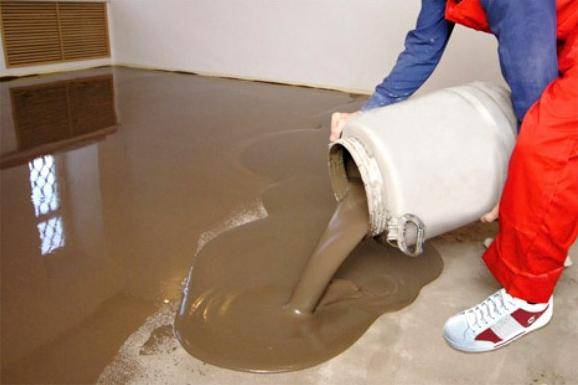
The room is poured in one go
Immediately after preparation, the solution is poured in strips of 30-50 cm and spread over the surface with a wide steel spatula. Fill fast enough, not allowing the edges of the previous strip to dry out. The room is poured in one go.
When the room is large, the floor is flooded with stripes through one, and the gaps are filled with the mixture after the previously filled bands have dried. Such an operation requires certain qualifications of the performers.
Floor leveling machines that can be pumped can be poured onto the base with special pumps, which significantly increases the productivity of the work. In this case, the width of the surface for one pass must be within 6-8 m.
Applying the leveling compound, strictly follow the manufacturer's instructions regarding the allowable thickness of the fill.
A smaller thickness can lead to problems with retaining water in the solution after pouring, as a result of which the strength of the leveling layer will decrease. A large thickness can lead to a "caramel effect" when a hardened solution remains in the normally hardened surface.
The duration of drying and curing depends on the composition of the concrete mixture, the thickness of the filling floor, humidity and room temperature, but the average time is indicated by the manufacturer on the package or in the instructions. As a rule, walking on a freshly laid floor is allowed in a few hours, partial loading is possible after a day, and a full load after 2-3 days.
Conclusion
Self-leveling mixtures are applied to almost any surface and, when there is time and desire, you can independently give your floor the necessary quality.
Publications on the topic
 Semen Knyazev
Semen Knyazev
You decided to make a quality repair in your house and finally level the old concrete floor? Professional builders recommend using specialmixtures for floor leveling and make a full-fledged screed, and not a "patch" surface repair. For alignment, you can apply both classic cement-sand mixtures, and modern leveling quick-drying compounds. They withstand heavy loads, do not dust and do not crack from temperature changes.
The main advantages of modern leveling compounds
For a high-quality floor leveling in an apartment, house or office, you are ideally suited ready mixes. You do not have to buy anything - to use them just add water to them and mix them well with a mixer or a conventional drill with a screw cap. Plastic mass immediately fill all the potholes and cracks, ideally leveling the surface.
Self-leveling floor mix for prepared floor
Among the main advantages of modern leveling mixtures:
- Easy to fill. Even a novice master will cope with it, observing our recommendations.
- High drying speed (up to 72 hours).
- You can move around the surface after 24 hours.
- Small thickness of the filling layer (up to 5 mm).
- A small weight of the layer (there will be no overlapping overloads).
- Good layer strength and durability.
The disadvantages of self-leveling mixtures are:
- Careful surface preparation process. On the basis there should be no deep cracks or potholes, strong vertical swings.
- Quite high cost for quality mixtures.
Another disadvantage is that the floor is difficult to dismantle. Therefore, you must understand that if you create it, it will serve you for at least ten years. Otherwise, you have to take a punch and knock down the floor, if you decide to change it.
Where to use leveling compounds
The leveling mortar can be used in any commercial, residential and industrial premises. With their help equal the concrete screed and even the wooden surface. Mixtures are used for both leveling and strengthening the surface. For example, a concrete screed "dusts", grains of sand and cement are constantly swept away from it, it is cracked by loads and temperature-moisture drops. If the top of the screed is topped with a mixture, then it will lose these drawbacks, it will not sag and let the moisture in. For rough leveling of the floor, there are special mixtures with which you can quickly create a high-quality rough floor or fill them with water pipes.

Before pouring the mixture to level the floor, prepare the base well
What mixtures can I buy?
The modern market of building materials offers buyers a sufficiently serious choice of leveling mixtures. They consist of a fine fraction filler, whose dimensions do not exceed 250 μm. Due to this, the screed of the mixture is more smooth than that of quartz sand. As a binder in a solution, cement or gypsum is usually used. Also, various additives are added to the mixture, which give the material good adhesion, plasticity and self-leveling properties.
If you have a height difference in the room of more than 2 centimeters, then you will use Knauf Nivellierestrich and Valery Plus. With their help, you can eliminate any swings and potholes on the surface of a thickness of 7 to 22 mm.
Note:if the height difference in your room is more than 25 mm, then we recommend you to make an equalizing screed. If for some reason this is not possible, then level the surface in two stages (no more than 22 mm).
No less popular today is the mixture of "Ventonit". She has wonderful technical characteristics and contains in its composition a full set of additives for fast congealing and plasticity. Good for leveling the surface with a height difference of 5 to 15 mm. At the same time, it has a high hygroscopicity, so painting it is not the best solution. it a good option for a rough floor covering, which will be covered from above with a laminate, linoleum or carpet.
The mixture "Horizon" consists of fine sand and cement. It is ideal for pouring a "warm floor" system, creating rough floors or leveling heavily damaged surfaces. It is allowed to apply the "Horizon" layer up to 10 cm. Among the advantages of this mixture is the possibility of coating with any paint, high hardness, good technical characteristics.

A mixture of Ceresite is an excellent choice for a smooth base
Ceresit CN -83 is the fastest-drying mixture among all presented. It seizes 10-15 minutes after application, and after 6 hours it is already possible to walk on the surface. The layer can be used after 24 hours - this is a record indicator for self-leveling floors.
Ivsil Termolite is an excellent choice for premises that can not be overloaded. This brand is well suited for leveling floors on balconies, in a loggia and living quarters, because it has excellent sound and heat insulation.
If you need to level wooden floors, gypsum or concrete screeds, GVL plates, then use the leveling mixture P2 class. It has high smoothing and spreading properties, seizes 15 minutes after application, and after 5 hours you can walk on the screed. In 12 hours you can lay linoleum on it, and in a day - a laminate. This is very convenient, because in order to exploit the standard cement-sand screed, you need to wait for almost a month. Class P2 is considered quite harmless - it consists of fine sand, pure gypsum, additives, resin and modifiers, giving the frozen surface not only an ideal evenness, but also a warm beige shade. This compound is excellent for living quarters, but in commercial it is not recommended to use because of low wear resistance.
Types of leveling mixtures
Before choosing and buyingmixture for floor leveling , decide what you need. Answer the following questions:
- How wet it will be in the room, i.e. whether the material will lie in the bathroom or in the bedroom.
- Will the floor be clean, or just level the surface and be closed with a laminate, linoleum or carpet.
- Will it be necessary to wash the surface with potent chemistry?
- On what basis the mixture will be poured.
- What additional requirements for the floor are put forward (heat and sound insulation, anti-skid).
- Will the mixture be decorative?
Based on these questions, you can find the right mix. There are not so many of them - you can easily figure out what exactly you need.

The main thing is to stir the mixture with quality so that no lumps or dry layers remain
Cement-based floors
Such mixtures are considered inexpensive. They practically do not dust because of the addition of special additives and resins to the mixture, and also perform a priming function. The average service life of the filler floor on the basis of cement is about three years. It has the following advantages:
- the material practically does not sit down;
- good adhesion;
- high strength;
- walk on the screed can be in 6-7 hours;
- can be filled even on a damp surface;
- high frost resistance, no cracks.
Main disadvantages:
- the floor can only be used after 3 weeks;
- the surface passes moisture on both sides;
- not very attractive appearance;
- high price.
Note:mixtures on a cement basis are 20-40% more expensive than gypsum. But their main plus is that the mixture can be poured even in a damp room and on not completely dried screed.
Gypsum-based floors
Gypsum mixtures are considered to be the most profitable and practical. They are often called anhydride. They are well suited for creating finish coatings and pouring systems "warm floor" (water and electric). Gypsum filler retains heat well, but does not like moisture: it is necessary to make a waterproof before filling. Such mixtures are environmentally friendly, do not shrink and dry up in just a few hours. The main requirement is a completely dry basis. The surface of such a coating does not emit dust and looks good due to its color and fine dispersion. In addition, gypsum filler allows you to create a screed thickness of up to 100 mm.
Floors based on epoxy resin
A quality and beautiful coating that has both pluses and minuses. It is very durable, does not leak moisture, is not afraid of aggressive chemistry, sun rays and temperature changes. The main drawbacks - yellowing over time, high price, average level of abrasion. The floor of epoxy resin can crack if you drop a heavy object on it, but it can be quickly repaired, covering a damaged area with a thin layer of new material.
Polymer based floors
These are the most modern and practical types of coating. As a filler, polyurethane, epoxy resin extract, methyl methacrylate, etc. is used. It has the following advantages:
- High strength, low abrasion.
- Withstands high loads.
- Resistance to solar radiation and temperature extremes.
- Good coefficient of moisture insulation, heat and noise protection.
Among the disadvantages can be a high price and exacting to the bottom. It should be smooth, without cracks and unevenness, since the average thickness of the leveling layer is not more than 5 mm.
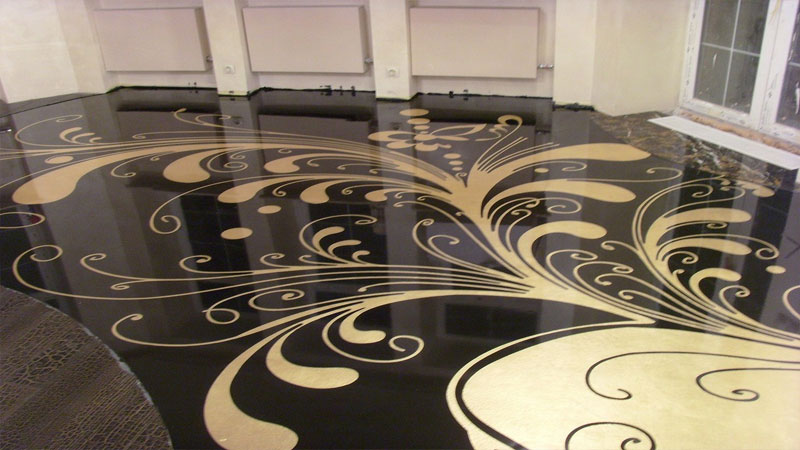
The mixture for leveling can be decorative and used as a finishing floor
How to apply?
After you have selected the material and prepared the substrate, you can proceed to the application of the layer. Cooking mixture is simple enough. You will need a large bucket or other even capacity. Pour the mixture into it, add the necessary amount of water (indicated in the instructions), and then mix with a drill with a nozzle or a mixer.
Note:you must carefully prepare the surface. It should not contain oil stains, paint, wet areas. Carefully sweep the base, removing all debris and dust from it.
- Surface preparation. Correction of all cracks and irregularities, removal of dust and debris.
- Primer. Use a deep penetration primer.
- Preparation of the solution (typically a 25 kg bag requires 6 liters of water). Stir it well until smooth.
- Pour the solution on the base, level with a spatula to the desired thickness. Usually, 5-15 mm is applied to the wooden substrate, 2-20 mm to the concrete.
- Roll the surface with a needle roller. He will remove the bubbles from the surface and further level it.
After this you will need to wait until the surface dries completely. The instructions say when you can walk on the floor and when you can use it. Usuallyleveling compounds for flooring dry for about 48-72 hours.
Flat floor is a necessary element for any room. Here, not only aesthetic motivations are involved. Flat floor can prevent injuries to property owners.
Precautionary measures
Many will agree that the view of the rickety cabinet is unpleasant. However, this can not be compared with the fall of a swinging TV set or the fracture of a limb that can be obtained practically on an "even place". The reasons for the formation of uneven sex can be many. For example, cracks and potholes that appeared during the operation, or errors made during construction. As a result, residents begin to worry about how to level the uneven floor.
Modern realities
Currently, the basis for sex is predominantly concrete. it refers to such premises as office, garage, apartment or house. Depending on their purpose, the following materials are placed on top:
- Carpet cover.
- Laminate.
- Parquet.
- Ceramic tile.
- Linoleum.
On how equal the concrete floor base will be, the longevity of the coating depends, which very often is quite expensive. Next, let's take a closer look at how to level concrete floors. 
Preparatory stage
Before doing so, clean the substrate of dirt and dust. Large cracks and chipped need to zashpatlevat. The entire surface must be treated with a deep penetration primer. A day after this, you can proceed to leveling. It is desirable that the bottom of the walls is covered with a special tape, but you can skip this step.
Process Features
In this case, the ultimate goal is to get a solid and even foundation. Also, do not forget about noise, hydro and thermal insulation. Align the concrete floor with your own hands can be using different materials and technologies. When choosing the right method, you need to take into account several nuances. This depends on the material of the finishing coat and the difference in the height of the floor. For example, if the level difference is 3-4 cm, then an equalizing floor screed is required. Also, there are often situations where the floor is generally flat, but there are many large cracks. In this case, the tile adhesive or leveling mixtures for the floor. The price of the materials is different. On average, it is about 200-250 rubles per 25 kg of the mixture. In many cases, the choice will depend on the size of the budget. There are several types of screeds, which differ in the way they are laid:
- Dry.
- With the addition of various liquids.
Dry type
This screed can easily be used even by a novice builder. She is able to significantly warm the room. In addition, a dry floor screed is not very expensive. The economy and ease of application, according to many consumers, are the main advantages of this method. The following elements are used as filler:
- Styrofoam.
- Dry quartz sand.
- Expanded clay.
Above can be laid out the following:
- Wood stoves.
- Gypsum-fiber moisture resistant sheets.
- Plywood.
According to consumers' recall, dry screed is one of the least labor-intensive ways of constructing a foundation. Due to the ease of installation, this option is often used in residential areas. 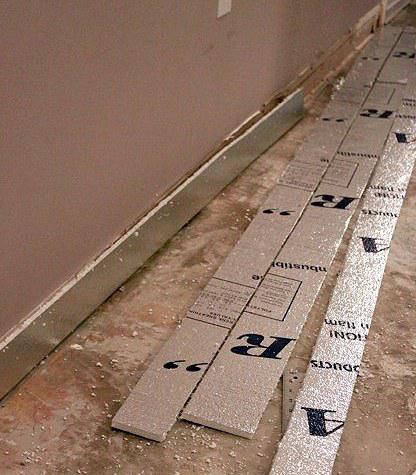
How to properly level the floor? First you need to prepare the base. The cleaned surface must be impregnated with a priming solution. The latter strengthens concrete and improves its waterproofing parameters. In this case, it is advisable to use "Concrete contact". After the drying has been completed, you can start laying a layer of polyethylene film, which should be more than 50 microns. The panels are overlapped (up to 20 cm), then glued together with adhesive tape. On the walls you need to leave the allowance (up to 15 cm). After that, everything is pasted damper belt.
Not everyone has enough experience in the construction sector and knows how to properly level the floor. Some recommendations will facilitate the task. Over the film, it is best to lay U-shaped profiles on the floor, which will be turned upside down. These will be kind of beacons established by the level. Part of the filler is poured into the formed cells. It is aligned with the rule. Next, you should lay the sheets of the future floor, for example, drywall. The joints of the coating are glued with PVA. The sheets are pulled together by screws every 18-20 cm. After they form a single monolith, a warm and strong floor will be obtained.
Cement-sand mortar
Many are asking not only how to level concrete floors, but also about what material is better to use for this. The majority decides to give preference to cement-sand mortar, since this option is classic. For the finish layer of the floor, it gives an even and firm foundation. The recommended thickness of the screed is not less than 3 cm, otherwise its strength will be significantly reduced.

Work algorithm
Before leveling concrete floors, as in other cases, you need to clean the base. Then you can begin to priming and drying. Beacons are installed using a laser, water or conventional level. They can also be done without help. To do this, you need to use the laser level. In most cases, beacons are T-shaped profiles or metal slats. Also for these purposes, you can apply a bar, a trimmed board or pipes. Reiki should be installed on a thick solution. The recommended distance is not more than a meter from each other.
It is necessary to wait for the solution to solidify. Otherwise, the beacons can be shifted during the alignment of the screed, and all have to start anew. It is necessary to show patience at the next stage of the work. The solution should emerge consecutively, starting from the far corner. The floor is thoroughly leveled by the rule. In this case, you need to move your arms around the circumference, and not just along the rails. The solution must move left-to-right. Thus, he can compact and fill all the voids.
Preparation of the solution
For these purposes, cement M500 is most often used. It mixes with water and sifted sand. Finished leveling mixtures are also often used. As a rule, the package contains all the necessary instructions. It is absolutely necessary to prepare the solution in accordance with them. The next day after completion of installation, the screed is slightly wetted with a roller. Then you need to re-moisturize. This checks the strength of the solution. If you can already walk on the screed, you should carefully remove the beacons. Then the formed voids should be filled with fresh solution. The screed should be covered with a plastic wrap. For the next week it should be periodically moistened. It is recommended to wait one month before hardening. 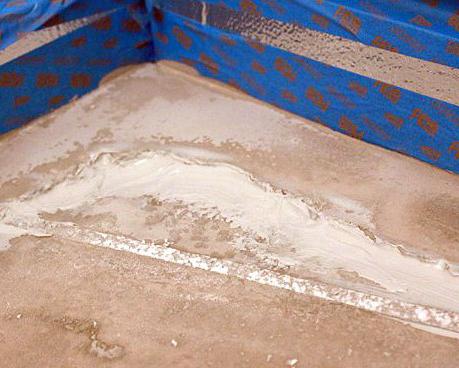
Fluid leveling floor
If the thickness of the finished coating is sufficiently small, it will give additional opportunities for its decoration in rooms with a low ceiling. Self-leveling blends are quite expensive. Consumers consider this circumstance to be one of the main drawbacks. In addition, they are distinguished by a weak resistance to low temperatures. This primarily applies to epoxy mixtures. Other varieties of them have other drawbacks. For example, mixtures made on the basis of polyurethanes, do not cope well with chemical effects. At the same time methyl methacrylic is unstable to abrasives. Very often on the floor there are small irregularities or cracks. In this case, it is advisable to align with a tile adhesive. However, it is not necessary to fully cover the floor with them.
When choosing a suitable mixture, factors such as:
- Financial and labor costs.
- Estimated loads.
- Difference in the level of heights.
- Slope of the concrete base.
- Humidity and temperature in the room.
Detailed Instructions
To level the concrete floor, you can use a high-speed self-flowing mixture called "Establish T-45 Scrolline." One package costs about 250 rubles. It is designed for 20 kg. The consumption of this mixture, compared with its analogs, is relatively small - about 13 kg per 1 sq. Km. m, while the layer is 1 cm. 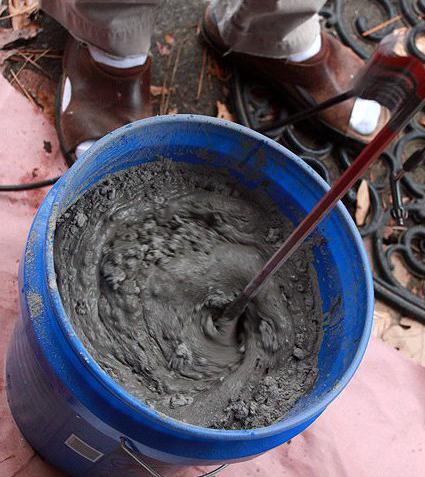
Tools and accessories
To work, you need a drill with a special nozzle and a needle roller equipped with a long handle, as well as a container for the preparation of a solution. In this case, you can not do without the paintkeepers. They can be done independently. You will need plates, the width and length of which will correspond to the parameters of the foot. You will also need an adhesive tape and screws (12 pieces for each). The latter are screwed into the boards. When they are needed for work, they simply need to be stapled to the feet. Water should be prepared in advance. One bag will need 7 liters.
Process Flow
You need to work at least together. The solution is made as follows: one bag of the mixture is gently poured into a bucket of water. Mix it with a mixer. While one worker is busy preparing the mortar, the other pours out the finished floor. You need to start from the far corner of the room. It is best to wear a paintbrush. Thus, it will be possible to walk on the floor without leaving any traces. Each portion of the poured solution is rolled using a needle roller. It will remove any air bubbles and ensure better spreading.
All the fill takes about 1 hour. After the entire area of the room is ready, it is necessary once again to walk along it with a needle roller. This will prevent further cracking of the coating. The advantage of this mixture, according to many consumers, is that it can walk on it two hours after application. 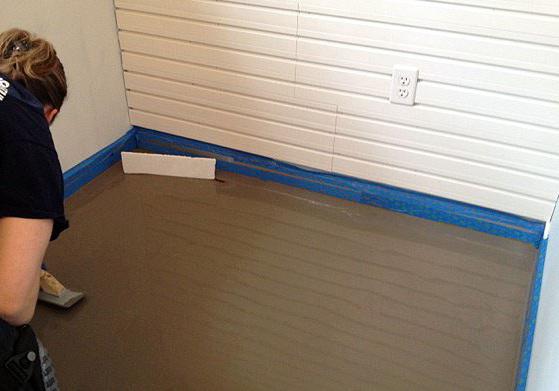
Additional Information
After the concrete floor has been finalized, ceramic tile can be spread out in three days, and after seven - cork, linoleum, carpet, laminate and parquet. The final drying of the mixture takes place about a month after its application. It is already possible to walk on such a surface. In particular, this becomes relevant for passage rooms, for example, such as a corridor. Approximate costs: three thousand rubles per room area of 12 square meters. m. It takes about two hours to work. In some places, small hillocks can turn out. This suggests that the roller did not work very well. This problem can easily be solved with sandpaper.
When it's time to repair, many people tear down the old flooring and are horrified to see the state of the floor in which it is. Especially if it is concrete - unevenness, cracks and chips on such a floor are very common. Before laying a new coating, all these defects must be repaired.
If the floor does not look like it was bombed, and the irregularities are not too big, there is no need to manually close each pothole and wait for weeks to dry cement screed. Modern technologies Allow to level the floor simply and quickly using self-leveling mixtures. They have an excellent ability to spread, dry up in a few hours, and the result is much better than when forming a traditional screed.
Advantages and disadvantages of leveling compounds
Despite the high plasticity of the mortar and the fineness of its layer, the strength of the floor leveled with such mixtures is very high - often in this respect the solutions exceed even the cement-sand screeds. In this regard, on the floor leveled by the leveling solution, you can put any decorative coating or even not put anything - the mixture for leveling the floor in themselves look decent enough to play the role of the finish coat.
Other advantages include the following:
- high rate of solidification - the solution becomes strong enough to walk on it in a few hours, and engage in finishing finish you can already the next day;
- simplicity of installation by the hands - it is necessary only to dilute a dry material with water and to pour out a solution on a floor, it itself will spread, having filled all roughnesses concrete foundation;
- high hardness, resistance to abrasion and mechanical damage;
- no shrinkage processes, so you can not be afraid that the leveling layer will crack;
- the layer of leveling solution can have a thickness of only 5 mm.

There are alignment solutions and drawbacks:
- the surface of the concrete substrate must be carefully prepared for work - cracks must be embedded, dust and debris removed;
- the removal of the leveling layer in case of errors during installation is rather complicated;
- the cost of dry mixtures is relatively high;
- before drying, some additives to the levels are toxic and pose a health hazard - inhaling emissions to the air can cause poisoning and allergic reactions, getting the mixture on the skin causes burns;
- fire hazard of liquid solution.
To avoid problems, you need to know in what conditions it is best to install the leveling layer. In addition, you must comply with safety and accuracy when pouring.
In which cases can I use equalizers?
 Leveling solutions can be used not only to correct the unevenness of concrete floors. They also have other purposes: priming the surface, getting rid of dust, making the surface smooth.
Leveling solutions can be used not only to correct the unevenness of concrete floors. They also have other purposes: priming the surface, getting rid of dust, making the surface smooth.
The drying speed of the mixtures plays an important role here, it causes a great breadth of application, since cracks do not form on the surface of the leveling layer due to rapid solidification. In addition, the layer is monolithic, not allowing even the smallest drops of moisture.
There are also rough mixtures for leveling the floor, which can be used to form a rough floor covering, for example, when pouring a warm floor.

The assortment of solution models is very wide, and the choice of one of them should not be based on which mixture is better, but for what purpose and under what conditions this material will be used.
The following points should be considered:
- humidity in the room;
- type of room on which it depends, whether the mixture will directly contact with moisture;
- whether the floor treated with an equalizing mixture will be cleaned using household chemicals;
- plan to level the floor for the finish coat or use as a coating mixture itself;
- base material, its performance characteristics, including hygroscopicity;
- do additional floor performance qualities, for example, lack of slip, absorption or reflection of sound, insulation.
Universal mixtures do not exist, for each specific situation you need to select a certain kind of leveling solution. Classification is based on the material underlying the composition of a mixture.
Blends based on cement with the addition of acrylates are cheap and excellent for dedusting and priming the floor. The thickness of the layer is quite small, because of which the coating service life does not exceed several years.
The pluses of such mixtures are:
- good adhesion to the base material;
- high strength;
- the possibility of applying on the basis of any quality, even on a very moist surface;
- resistance to low temperatures;
- quick initial drying.
However, cement mortars are not very resistant to moisture, and their full hardening takes several weeks. The disadvantages include the inability to use as a finish coat because of an unattractive appearance and a large consumption of material.
The mortar is installed according to the type of screed: the floor is prepared, the zero level is determined, then the solution is poured onto the substrate and leveled with a rule.
 Gypsum mixtures are even cheaper, but they have a significant drawback - their application is permissible only in extremely dry rooms. But solutions based on gypsum are very undemanding to the state of the base, and also conduct a great heat, which makes them ideal candidates for the construction of a warm floor system. In addition, the gypsum dries very quickly, does not shrink and consists only of natural materials, which ensures its complete safety for health and ecology.
Gypsum mixtures are even cheaper, but they have a significant drawback - their application is permissible only in extremely dry rooms. But solutions based on gypsum are very undemanding to the state of the base, and also conduct a great heat, which makes them ideal candidates for the construction of a warm floor system. In addition, the gypsum dries very quickly, does not shrink and consists only of natural materials, which ensures its complete safety for health and ecology.
Using gypsum mortar, you can get a thick screed, the size of which, unlike the cement variant, is practically unlimited. This is useful if you want to align very noticeable elevations. By strength, the gypsum screed surpasses the concrete.
 Mixtures based on these substances are distinguished by the highest degree of adhesion to the substrate. In addition, they are very firm and fairly resistant to chemical attack. The disadvantages of epoxy leveling mixtures, however, are quite significant - it is a weakness for abrasion, low resistance to mechanical influences, slip when wet.
Mixtures based on these substances are distinguished by the highest degree of adhesion to the substrate. In addition, they are very firm and fairly resistant to chemical attack. The disadvantages of epoxy leveling mixtures, however, are quite significant - it is a weakness for abrasion, low resistance to mechanical influences, slip when wet.
Covered with a layer of epoxy material, the floor can easily become covered with cracks from the impact of a heavy object. In kitchens and bathrooms, such mixtures should not be used.
 The composition of leveling mixtures can include a variety of polymer compounds: polyurethane, methyl methacrylate and much more. To the advantages of sexes, leveled by such solutions, you can refer:
The composition of leveling mixtures can include a variety of polymer compounds: polyurethane, methyl methacrylate and much more. To the advantages of sexes, leveled by such solutions, you can refer:
- high strength, resistance to vibrations, shocks and pressure, which makes polymer blends an ideal choice for industrial and storage facilities;
- resistance to temperature fluctuations within wide limits;
- long service life without loss of performance and fresh appearance;
- resistance to moisture and chemistry;
- ability to absorb sound.
The disadvantages are the need to fill only on a dry basis and high cost.
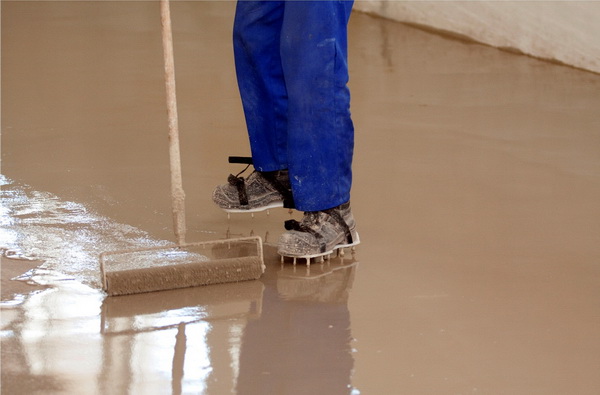
The process of dilution of the solution is simple - just add the water in the amount recommended by the manufacturer to the dry mixture. It is not necessary to overflow or pour, as in this case the mixture will certainly lose some of its qualities. After this, the solution must be thoroughly mixed until a mixture is formed without lumps and air bubbles.
For mixing it is better to use a construction mixer or electric drill. After a few minutes you need to stir it again, then you can start pouring. The mixture begins to dry after half an hour, so prepare the solution in small portions.
After the preparation of the solution, the floor is prepared: it is cleaned of dirt, oil stains, dust and debris. The surface must be thoroughly dried for most mixtures. It should also be taken into account that the temperature in the room should not be lower than five degrees.
The next step is applied primer. When it dries, a diluted solution is poured with a layer 2 to 20 mm thick. The cast mixture is rolled with a roller with needles to remove formed air bubbles. After that, you just have to wait until the solution dries. The floor will be ready for use in a day.
